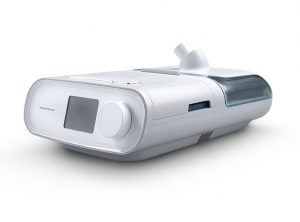Our DreamStation CPAP recall lawyers are currently seeking new cases from individuals who used one of the recalled DreamStation devices and suffered health consequences related to the inhalation of chemicals from the device.
If you used a Philips DreamStation, DreamStation Go, or another recalled CPAP machine for 6 months or longer and have suffered cancer or other negative health consequences, you may be entitled to compensation.
What led to this recall and DreamStation lawsuits? A few weeks ago, Philips Respironics announced it was recalling all of its popular DreamStation sleep apnea machines because they may cause users to unknowingly inhale toxic, potentially carcinogenic chemicals
Philips DreamStation CPAP Machine
Millions of people in the U.S. suffer from sleep apnea, a medical condition in which a person regularly stops breathing during sleep. Over time, the constant interruption of oxygen during sleep can have serious adverse health consequences, including heart attack and stroke.
 CPAP or “Continuous Positive Airway Pressure” therapy is the most common and effective treatment option for sleep apnea. CPAP devices are worn at night and they administer a stream of continuous positive air pressure into the breathing pathways through a mask.
CPAP or “Continuous Positive Airway Pressure” therapy is the most common and effective treatment option for sleep apnea. CPAP devices are worn at night and they administer a stream of continuous positive air pressure into the breathing pathways through a mask.
This continuous stream of gentle air pressure essentially forces the user’s airways to remain open and prevents the collapsing of the airway associated with sleep apnea.
Philips is a global medical device company and the Philips Respironics division designs and manufactures a full line of devices for the treatment of sleep apnea.
DreamStation is the company’s flagship brand for its line of CPAP sleep apnea devices. This line of products includes the original DreamStation CPAP, DreamStation Auto CPAP, and the travel-sized DreamStation Go.
A DreamStation CPAP is a small, table-top console that attaches to a tube that feeds into a mask. Its purpose is to combat sleep apnea, a potentially serious medical condition in which the patient either stops breathing or experiences respiratory depression while sleeping. Sleep apnea and the resulting respiratory depression is often caused by obstructions of the upper airway (frequently tonsils or excess skin).
The Dreamstation CPAP machine combats sleep apnea using positive air pressure to keep the patient’s breathing pathway open.
Problems Sound Abatement Foam in DreamStation Devices
The DreamStation, and all other brands of CPAP and BiPAP machines made by Philips prior to May 2021, utilize a special type of polyurethane foam called PE-PUR.
The PE-PUR foam is used in all parts of the DreamStation for sound abatement to make the machines run quieter at night. Unfortunately, this PE-PUR foam presented hidden dangers that eventually prompted the recall.
Back in April, Philips issued a public warning related to the DreamStation and other CPAP machines. In this safety announcement, Philips explained that the PE-PUR sound foam in the DreamStation devices was prone to breakdown and degrade over time. When the foam degrades it releases tiny particles that circulate into the machined and get inhaled by the user.
According to Philips, lab analysis showed that the airborne foam particles contained numerous chemicals that could be potentially harmful and carcinogenic.
This is what effectively forced Philips to announce a global recall of all DreamStation devices made prior to 2021. In the recall notice, Philips stated that inhalation of chemicals in the PE-PUR foam could cause DreamStation users to suffer serious and even life-threatening health consequences.
DreamStation Recall Lawsuits
The emergency recall of the DreamStation and other Philips CPAP devices is expected to lead to a wave of lawsuits by former users who suffered health consequences from inhaling the toxic PE-PUR foam. Over the next few months, there will likely be a host of scientific studies done to evaluate the specific health risks posed by the use of the recalled devices. Once this research establishes a clear link between the inhalation of the PE-PUR foam and certain medical conditions or types of cancer, Philips could face billions in liability.
It appears that Philips may have been well aware of the risks and problems related to the PE-PUR foam a long time before they issued the warnings and recalls.
Curiously, Philips appears to have deliberately waited to issue the recall notice until AFTER it released a “next-generation” DreamStation sleep apnea machines that do not contain the harmful PE-PUR foam. DreamStation lawyers will learn more during discovery but this appears to be a classic example of placing business interests over the health and safety of users.
When Will the DreamStation Recall Lawsuits Settle?
It is too early to predict if or when the DreamStation recall lawsuits will settle or even if they will reach a settlement. Historically, mass tort class action cases like this will be often take years before reaching a settlement.
Problems Sound Abatement Foam in DreamStation Devices
Lawyers cannot accurately estimate the DreamStation recall settlement amounts at this point because the litigation is so new. Typically, product liability cases where cancer is the injury can reach and surpass $500,000.
Is that $500,000 settlement figure one you should use as an anchor to estimate the settlement value of DreamStation recall lawsuits? Absolutely not. Any settlement compensation talk at this point is pure speculation.
Contact Our DreamStation Recall Lawyers Today
If you think you were injured from using a DreamStation sleep apnea device, you may be able to file a CPAP machine lawsuit against Philips and receive substantial financial compensation. Call our medical device lawyers today at 888-322-3010 to see if you have a case.
 Lawsuit Update Center
Lawsuit Update Center


